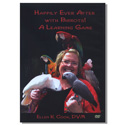Far, far away
It's cold. It's winter. It's boring.
Let's travel, at least in our minds. Let me introduce you to my long-time pen pal, Shanlung, probably one of the best bird clicker trainers on the planet.

Shanlung and his parrot, Tinkerbell, exploring the
Nan Heng Gong Lu (Southern Cross Taiwan Highway).
A world-class bird clicker trainer
Shanlung is not his real name; this pen name means Mountain Dragon. Shanlung is an engineer who designs and builds huge projects—bridges, dams, harbors—in remote parts of the world. During assignments he often brings along his wife, his cats, and his birds. They do quite a lot of truly frightening sightseeing (frightening by my standards, hating heights) on motorcycle. Always with a bird.
Most of Shanlung's birds have been parrots, trained to free-fly, an elaborate procedure starting with the bird on a harness and safety line. If you prowl through his live journal you will see him flying one or another bird around Tibetan monasteries, Arab desert villages, and the abandoned wadis and ruins where he and his wife like to picnic on his days off.
Reading the bird-ish mind
Between assignments, Shanlung and his wife live in Singapore. This past year Shanlung has been experimenting with some of the native songbirds Singaporeans keep in cages as pets. (These birds are usually released in appropriate territory in due course.) Shanlung reports his findings through his live journal, findings that range from his very careful work on diet design, to observing, recording, and responding to social behavior directed toward the trainer.
The interesting thing to me, and to Shanlung, I think, is not just the training successes— getting the bird to fly free around the apartment, come on cue, target, and so on. It is discovering, through the clicker interactions, how that species of bird thinks, and what is appropriate and interesting for it.
Clicker training doesn't just take away the fear and give you control. That's the utility, but that's not the key benefit. More exciting is the way it builds a real communication with the animal, whatever the species. Trainers become, to the animal, a sort of weird species-mate:
"I understand what you mean, and I presume you understand what I mean, too."
The animal is not "trying" to communicate; it is communicating, by giving you, the trainer, the same emotional information it would give another animal.

Shanlung with his bird, Riamfada (on shoulder) and
cat, Dommie, enjoying the tide pools of the
Sultanate of Oman in Southwest Asia.
Go adventuring with Shanlung
An excerpt from Shanlung's journal starts out with a complaint about his new cat (who has him perfectly trained, as you will see). What follows is a running account of his current bird project—Jackie, a wild-caught adult mynah that is proving to be a very strong-minded individual with a tempestuous, emotional nature. Again, as you will see.
A lot of bird specialists (zoo people, etc.) follow Shanlung for the aviculture wisdom. I follow him for training sagas and the careful thinking he puts into each interaction. I also follow him for the jokes, such as the two brief theater reviews in the blog excerpt.
I hope you enjoy "meeting" Shanlung. Be sure to browse the photography in his previous journal entries—awesome!









Post new comment